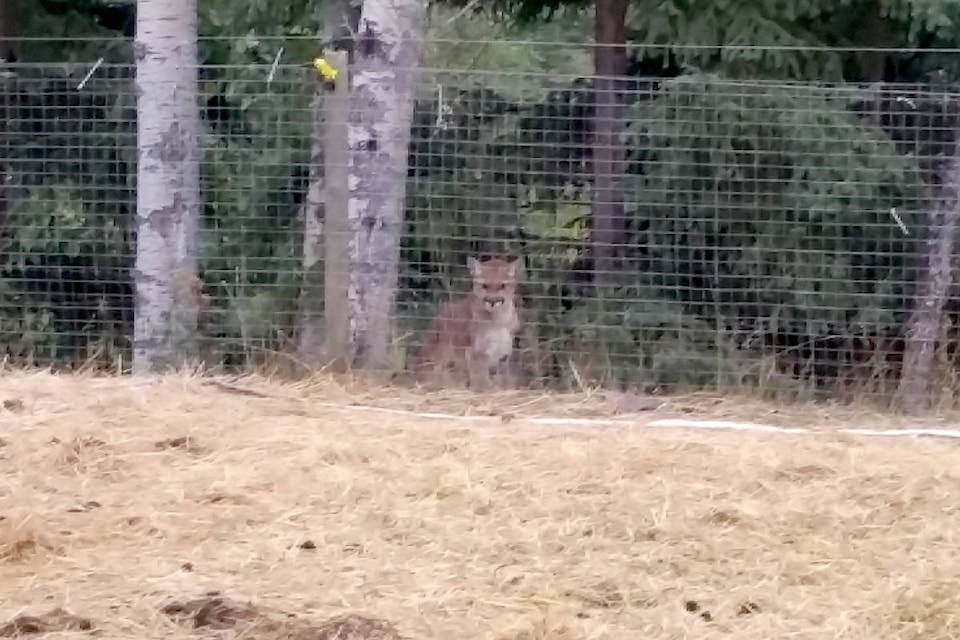The wildfires have some folks in the area noticing wildlife, some of them wondering if the numbers are increased, particularly with the deer, bears and cougars noted on social media.
CO Sgt. Len Butler says local wildlife reports have been “pretty steady” with no increase in the number of predator conflicts this fall, overall. It is also unlikely that wildlife sightings have gone up, either, since the summer’s agressive fire behaviours, he adds.
Butler explains the COs have seen about the same volume of complaints and conflicts reported as an average autumn.
“It seems about normal … it’s been pretty steady, it’s not unusual for what we’ve been dealing with.”
The Conservation Officer Service (COS) is reminding residents to take precautions, as always, when fall and winter can increase wildlife activities in neighbourhoods – most often due to our own, controllable habits.
Butler says people “feeding wildlife” do create a problem by attracting predators into their neighbourhoods – particularly endangering folks with small domestic pets or more vulnerable livestock.
“The reality is, a lot of people leave their feed bags out – there’s that smell of the grain that brings bears in. You have to think the whole gamut.
“As long as this has been around, people and animals, our biggest problem is fruit, and attractants like garbage – it does not change, year-to-year-to-year.”
Residents need to pick their own fruit off their backyard trees, canes and shrubs to avoid endangering their local community, he explains, adding they might help their elderly or disabled neighbours by offering to help them with this task.
If you must have them, it’s best to clear any fruit-bearing trees and bushes as soon as possible, otherwise Butler’s advice is “at the very least, if it hits the ground, pick it up quick.”
Attractants like garbage and grain do bring in bears, and while they don’t usually bring in wildcats, a large population of deer – like when someone is feeding them – can certainly result in more cougars, he explains.
While it isn’t illegal to feed deer themselves, it is strongly discouraged by the COs and often leads to wildcats coming in after them, Butler says, adding anyone attracting bears, cougars, wolves or any other predators can face criminal charges.
“It is contrary to the Wildlife Act, it is an offence. If you are attracting predators, not only do we have to now deal with that predator, we’ll have to deal with the resident on that matter, also. And we’d prefer not to, obviously – but we have to make sure of everyone’s public safety, and their animals.”
Butler says electric fencing can be effectively used for preventing access to all sorts of wildlife. While some of the better jumpers, like deer, can certainly scale most fences, typically, most won’t bother to enter a confined area when an easier “menu item” is available.
“Ranchers have been using it for years; and orchardists, they are using it to keep the deer out.
“The 100 Mile House area has lots of black bears and a very good population of cougars … do what you can, and think about how much it’s rural here.”
This includes keeping tabs on smaller pets targeted by predators, keeping them indoors dusk-to-dawn where you can, setting up motion lights outdoors, he explains.
The sergeant adds that sharing with your online groups when sightings are made, to notify them about predators before any conflicts bring in the COs with their hounds, can be a very useful tool to keep their neighbours alert.
A cougar that attacked three mini-horses near Lone Butte on Sept. 17 , was sighted again, but is still at large. While 100 Mile House COs responded, the timing of reports is so essential in tracking predators successfully, Butler explains.
“When we got the information, again, it was too late.”
Butler asks anyone, anytime with any wildlife conflict in the region or finding animal injuries likely due to predators to call in immediately to (toll-free) 1-877-952-7277 (RAPP).
Anyone who sees a cougar in the general vicinity of Katchmar Road or McMillan Road is asked to report it immediately, due to the continued risk, he says, adding the line is answered 24/7 and gets quickly passed on to a local CO to respond to it.
“The [CO] will be there. It does not matter the time, he’ll roll.”
